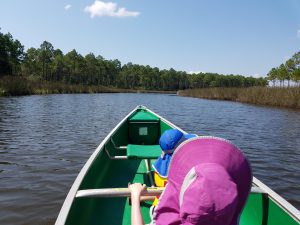
Local estuaries are a beautiful place to explore with your family. Credit: Matthew Deitch, UF IFAS Extension
Florida’s rivers, springs, wetlands, and estuaries are central features to the identity of northwest Florida. They provide a wide range of services that benefit peoples’ health and well-being in our region. They create recreational opportunities for swimmers, canoers, and kayakers; support diverse wildlife for birders and plant enthusiasts; sustain a vibrant commercial and recreational fishery and shellfishery; serve as corridors for shipping and transportation; and support ecosystems that help to improve water quality. Maintaining these aquatic ecosystem services requires a low level of chemical inputs from the upstream areas that comprise their watersheds.
Aquatic ecosystems are especially sensitive to nitrogen and phosphorus, which are key nutrients for the growth of plants, algae, and bacteria that live in these waters. High levels of these nutrients combined with our sunny weather and warm summer temperatures create conditions that can lead to rapid growth of aquatic plants and algae, which can cover these water bodies and make them no longer enjoyable for people and wildlife. It can also cause dissolved oxygen levels to fall, as plants respire (especially at night, when they are not photosynthesizing) and as bacteria consume oxygen to break down dead plant material. Low dissolved oxygen can create conditions that are deadly for fish and shellfish.
The Florida Department of Environmental Protection (FDEP) lists more than 1,400 water bodies (including rivers, springs, wetlands, and estuaries) as impaired by pollutants. Many of these are impaired by excessive nitrogen or phosphorus. It is a daunting challenge to reduce pollutants in these water bodies because their inputs frequently come from all over the landscape, rather than a specific point—nutrients can come from agricultural fields, residential landscapes, septic tanks, atmospheric deposition, and livestock throughout the watershed.
In Florida, FDEP has begun a program to reduce nutrient concentrations in impaired watersheds by collaborating with landowners and other stakeholders to develop management programs to reduce pollutants entering the state’s waters. This pollutant reduction program is currently focused on Florida’s spring systems, including Jackson Blue Spring and Merritt’s Mill Pond in Jackson County. Merritt’s Mill Pond is a 4-mile long, 270-acre pond located near Marianna, and it is a popular regional destination for swimming, boating, kayaking, and fishing in the Panhandle. Its main source is Jackson Blue Spring, which produces, on average, more than 70 million gallons of water each day. Excessive growth of aquatic plants and algae in the pond during summer reduces the area available for swimming and boating. In 2014, FDEP began working with agricultural producers, residents, developers, local government officials, and other stakeholders to identify nutrient contributions in the Merritt’s Mill Pond watershed and develop an action plan to reduce nutrients entering the pond in the coming decades. Collaborations with stakeholders help to improve the accuracy of pollutant estimates, and to ensure the plan is designed appropriately to achieve desired ecological outcomes.
This Action Plan for reducing nutrients into Merritt’s Mill Pond provides an opportunity for land managers to implement their own plans to reduce nutrient contributions without FDEP imposing rigid regulations or mandating particular actions. People can choose from an array of Best Management Practices designed to reduce nutrient contributions, and the state has made funds available for people to help implement these plans. Implementing this Action Plan will restore the wonders of Merritt’s Mill through the 21st Century.
This article was written by: Matthew J Deitch, PhD, Assistant Professor, Watershed Management with the UF IFAS Soil and Water Sciences Department at the West Florida Research and Education Center. For more information, you can contact him at mdeitch@ufl.edu or 850-377-2592.
- Hurricane Season 2025 - July 7, 2025
- The Striped Burrfish - April 11, 2025
- The Value of Biodiversity - March 28, 2025
